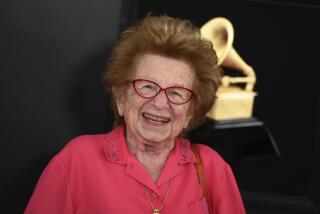Judith Wallerstein dies at 90; psychologist was described by Time magazine as the ‘godmother of the backlash against divorce’
- Share via
In 1970, preschool teachers asked Marin County psychologist Judith Wallerstein how to deal with a rash of children who couldn’t sleep, cried constantly or were too aggressive with playmates. The common denominator, the teachers said, was that the parents were divorcing.
Wallerstein looked for research on the issue and, finding nothing useful, decided to conduct her own. She launched what would become a 25-year investigation, producing alarming findings that made the long-married grandmother of five a polarizing figure in a contentious national debate.
Once described by Time magazine as the “godmother of the backlash against divorce,” Wallerstein died June 18 in Piedmont, Calif., after surgery for an intestinal blockage, said her daughter Amy Wallerstein Friedman. She was 90.
When Wallerstein began looking at the impact of divorce, she thought the children’s difficulties would be fleeting. Instead, she found that for half of the 131 children she studied, time did not heal their wounds but allowed them to fester, creating “worried, under-achieving, self-deprecating and sometimes angry young men and women” who, not surprisingly, struggled considerably with romantic relationships.
In light of this delayed effect, Wallerstein came to a controversial conclusion: If parents could swallow their misery, they should stay together for their kids.
“What in many instances may be the best thing for the parents may by no means be the best thing for the children,” she told Newsday in 1994. “It is a real moral problem.”
She wrote about the consequences of divorce in several books, including “Second Chances: Men, Women, and Children a Decade after Divorce” (1989) and “The Unexpected Legacy of Divorce” (2000). Coauthored by Sandra Blakeslee, the books made headlines, put Wallerstein on talk shows and magazine covers, and became bestsellers.
Family values proponents embraced Wallerstein’s research, but detractors found much to criticize. Many critics said her sample was too small, lacked a control group for comparison and was slanted toward families with psychological problems that preceded the divorce. Larger and more scientific studies by other family experts have supported some of Wallerstein’s findings and debunked others.
Andrew J. Cherlin, a Johns Hopkins University sociologist who wrote the 2009 book “The Marriage-Go-Round,” said last week that Wallerstein’s most important contribution “was to show that the effects of divorce could sometimes appear on a delayed basis in young adults — something she called a ‘sleeper’ effect.”
Despite the caveat that her findings apply mainly to troubled families going through divorce, Cherlin said her work remains influential.
“People still cite it and argue for or against it,” Cherlin said.
Wallerstein began her studies at a propitious time. In 1970, California had become the first state to enact no-fault divorce, and other states rapidly followed its lead. Divorce rates began to climb.
Taking a case study approach, Wallerstein recruited families who had sought marital counseling at her therapy center in Corte Madera. She wound up with a group of 131 children from 60 middle-class Marin County families that were going through divorces in 1971. She interviewed the children every five years for 25 years and found that as young adults half of them had problems such as rage, depression, alcohol abuse, physical abuse and school failure. Developing intimacy and trust was especially tough.
“What we’d been telling parents for years was that divorce is difficult for children, but in time, they’d adjust,” she told The Times in 2000. “We didn’t know its effects would be so powerful for such a long time, that it would be a factor as young adults look for love.”
Born Judith Hannah Saretsky in New York City on Dec. 27, 1921, Wallerstein experienced a major trauma early in life. Her father, a director of Jewish community centers, died of cancer when she was 8. Wallerstein did not know how grave his illness was and for a long time denied he was dead.
“You can trace all this work to my own suffering as a child and how my mother tried to handle the situation,” she told the Baltimore Sun in 1997. “I know the importance of an intact family, about the importance of fathers.”
She spent her teenage years in Tel Aviv, where her widowed mother taught English. She returned to New York to attend Hunter College and Columbia University, where she earned a master’s in social work in 1946. She underwent psychoanalytic training at the Menninger Clinic in Topeka, Kan., where she met Robert S. Wallerstein, who was also studying there. They married in 1947.
She and her husband later moved to the Marin County town of Belvedere. Wallerstein earned a doctorate in psychology from Sweden’s Lund University in 1978 and was a lecturer at UC Berkeley’s School of Social Welfare from 1966 to 1991.
She is survived by her husband, daughters Amy and Nina, and five grandchildren. A son, Michael, died in 2006.
In the 1990s, she realized that two decades of dwelling on the effects of marital failure had made her rather depressed, so she decided to study the flip side and with Blakeslee wrote “The Good Marriage: How and Why Love Lasts,” published in 1995.
More to Read
Start your day right
Sign up for Essential California for the L.A. Times biggest news, features and recommendations in your inbox six days a week.
You may occasionally receive promotional content from the Los Angeles Times.







